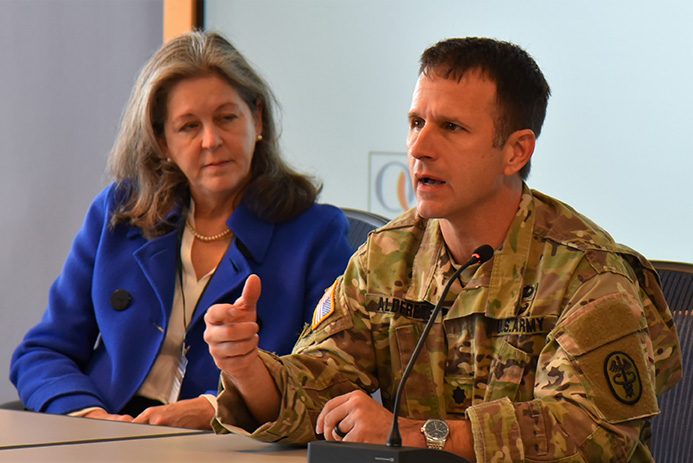Experts Meet to Discuss Blast-Injury Limb Salvage Options

To amputate or salvage a limb is a dilemma physicians and surgeons can face after their patients suffer a blast-related injury. Either decision can lead to its own risks and benefits, but which decision answers the question: what's the best thing for the patient, in the moment and in the long term?
The U.S. Army Medical Research and Materiel Command's Department of Defense Blast Injury Research Program Coordinating Office partnered with the RAND Corporation to hold the eighth DOD State-of-the-Science Meeting Mar. 5-7, in Arlington, Virginia.
"The purpose is to address a very specific blast injury problem and to identify what's known and what's unknown about that problem," said Michael Leggieri, director, DOD Blast Injury Research Program Coordinating Office, USAMRMC.
"We're trying to identify knowledge gaps and then recommend either research or policy changes or other things that can be done to close these knowledge gaps," added Leggieri, "and ultimately deliver better prevention and treatment to Service Members."
Leggieri continued, adding that these valuable meetings bring together experts from very diverse communities and disciplines to help solve difficult problems and recommend solutions to better protect and care for those who serve this Nation.
More than 80 people listened to speakers and participated in working groups that were designed to help find solutions and identify gaps in research associated with "Limb Salvage and Recovery After Blast-Related Injury."
"The level of expertise and knowledge in the room was astonishing," said Akua Roach, Ph.D., program manager for the Peer Reviewed Orthopaedic Research Program. "Researchers, surgeons, clinicians, funders, and policy makers provided perspective that could not be captured by even the most comprehensive of literature reviews."
"Having a chance to listen to presentations about advances in surgical research, technologies, and rehabilitative care followed by scientific presentations by researchers in this space, allowed us all to have a deeper understanding of the state of the science, and the state of the problem" added Roach, who considers knowledge and technology gaps associated with the care of Service Members, Veterans and civilians that sustain orthopedic injuries to help guide the program's investment strategies.
The three-day meeting consisted of speaker presentations on the first two days and working group presentations on the third day. There were also panel and poster sessions along with presentations on blast injuries, limb salvage, which included resuscitation and repair, nerve injuries and treatment, wound infections, ossification, and outcomes.
"Perhaps, one of the biggest challenges is actually being able to standardize outcomes and so doing randomized controlled studies in some settings is next to impossible," said Col. David Saunders during his "Using Regenerative Medicine to Repair Wounded Limbs" presentation.
Later, Saunders added, "I think another important point is the idea of failing early and inexpensively.
"Better to fail in an early pivotal trial that is designed to kill the product than to make it through to Phase 3 clinical trials and find that you've wasted several hundred millions in dollars."
Saunders also informed attendees that simple and elegant products are more likely to make it to and restore function in patients due to a shorter regulatory pathway than super products that try to combine multiple functions in one product.
"There's clearly no single solution to some of these complex injuries, so our focus for now is trying to develop a toolkit...," said Saunders.
When attendees broke out into their working groups, they were asked to answer five groups of questions:
- Question 1: How big is the problem of severe blast-related limb injury? What research is needed to better characterize the magnitude of this problem?
- Question 2: What factors figure into the immediate and ongoing decision to salvage versus amputate a limb after severe blast-related limb injury? What research is needed to better guide this decision? What are the promising strategies for preventing potential neurological effects of repeated military occupational blast exposure?
- Question 3: What are the most promising innovations for restoring and reconstructing a salvaged limb after severe-blast related limb injury? What research is needed to understand their effectiveness and limitations? What outcomes should be studied?
- Question 4: What are the most promising rehabilitative innovations after limb salvage for severe blast-related limb injury? What research is needed to understand their effectiveness and limitations? What outcomes should be studied?
- Question 5: What are the most important research, technology and policy opportunities and gaps pertaining to limb salvage after severe blast-related limb injury?
Participants presented their group consensus on the third day. After the presentations concluded the open portion of the meeting adjourned. A closed meeting was held to compile the information and input gained. The RAND Corporation will take the findings from the session and create a report that will help the Blast Injury Research Program Office identify scientific gaps and areas of research to focus on.
The report is scheduled to be available on the DOD Blast Injury Research Program's Website by the last quarter of 2019. For information about the DOD's blast injury research or to see what findings were discovered, go to: https://blastinjuryresearch.health.mil/.
"My biggest take away from this meeting is that we still have a lot of work to do in addressing limb salvage capability gaps," said Roach. "The breadth of the unknowns may seem overwhelming but, after attending this meeting, I believe that we can harness what we do know, provide researchers the resources to address what we don't know, and close some of these capability gaps in the near future."














